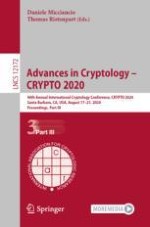2020 | OriginalPaper | Chapter
Improved Differential-Linear Attacks with Applications to ARX Ciphers
Authors : Christof Beierle, Gregor Leander, Yosuke Todo
Published in: Advances in Cryptology – CRYPTO 2020
Publisher: Springer International Publishing
Activate our intelligent search to find suitable subject content or patents.
Select sections of text to find matching patents with Artificial Intelligence. powered by
Select sections of text to find additional relevant content using AI-assisted search. powered by

